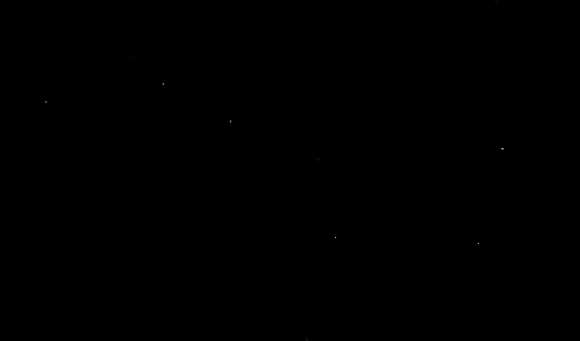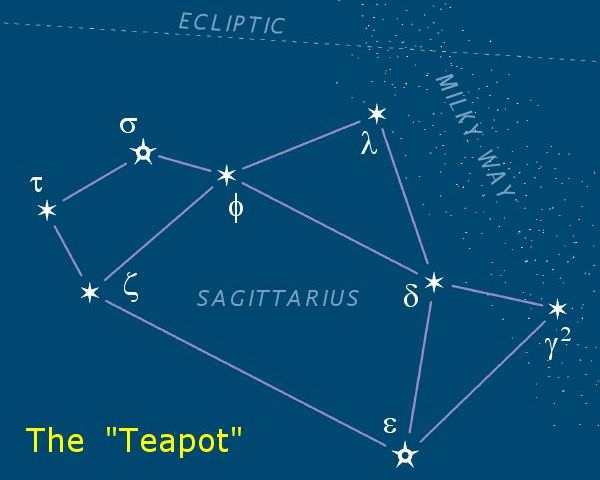[/caption]
Humans have been grouping stars into patterns since the beginning of time, each culture placing its own myths and folklore in the sky, but it wasn’t until 1930 that the International Astronomical Union (IAU) divided the sky into 88 constellations each with its own strict boundary. Though many of these are well known, and the stories they depict are well documented, few look like the figures they are supposed to represent. Asterisms are more user friendly guides and the starting point for most astronomers. These bright, simple, more prosaic shapes, stand out among the constellations and often serve as useful landmarks, pointing the way to celestial delights!
The best known and most instantly recognisable asterism is probably the Plough or Big Dipper in Ursa Major. Two of its stars, Merak and Dubhe, (The Pointers) pointing the way to the North Star Polaris in Ursa Minor. NASA’s Juno spacecraft stopped on its 5 year journey to Jupiter on March 21 to capture this image of our best known asterism:

In the Northern hemisphere, each season is heralded by its own asterism: The Autumn sky is dominated by the great Square of Pegasus, formed by stars from both Pegasus and Andromeda and its top left corner points the way to the Andromeda Galaxy, just a hop, skip and jump away. Most people recognise the three stars Alnitak, Alnilam and Mintaka, making up the Belt of Orion, which shines bright in the Winter sky indicating one of the richest regions in the sky, the Orion Molecular Cloud Complex. The Diamond of Virgo marking the Spring, consists of Arcturus (Boötes), Spica (Virgo), Denebola (Leo) and Cor Caroli (Canes Venatici). These encompass the constellation Coma Berenices and many of the galaxies within the Virgo Cluster. The Summer Triangle of Deneb (Cygnus), Altair (Aquila), and Vega (Lyra) currently sails over us guiding the way to the Ring Nebula in its top right corner.
Searching for Leo? Look for the Sickle, a backwards question mark that represents the lion’s head. Hunting for Hercules? The Keystone is the key and you will also find the Hercules Cluster (M13) on its right hand side. Boötes is easier to spot if you look for the Kite or Ice Cream Cone, than try to make out an ox driver! Not many people can see poor Queen Cassiopia, punished for her vanity to circle the heavens, but the W that marks the constellation is instantly recognisable. The Circlet is a lovely signpost to one of the fish of Pisces. You’d be hard pressed to recognise Sagittarius as the centaur it depicts, but there is the Teapot (Bertrand Russell was right, there is a celestial teapot!) showing the way to this rich patch of sky.
The Southern hemisphere has no shortage of asterisms either, most notably Argo Navis which represents the entire ship Argo sailed by Jason and the Argonauts and would be the largest constellation in the sky if it hadn’t been broken up in 1752 by French astronomer Nicolas Louis de Lacaille into the constellations we know today as Carina (the keel), Puppis (the poop deck) and Vela (the sails). Also in the Southern hemisphere are found The Three Patriachs in Triangulum Australe and the Fish Hook in Scorpius among others.
There are many more obscure asterisms too. Job’s Coffin graces the constellation of Delphinus, Asses and the Manger are in Cancer, Poniatowski’s bull (named for the King of Poland) is part of Ophiuchus and Aquila. There are the Lozenge, Saxophone, Coathanger, and many more.
The sky can seem a bewildering place, filled with gods, kings and mythical creatures. Asterisms like the Teapot make a more welcoming and friendly introduction, allowing a novice stargazer to easily pick their way around the sky and gain confidence and as many stars get swallowed by increasing light pollution, asterisms still shine out to show the way.
Find out more about asterisms here.

